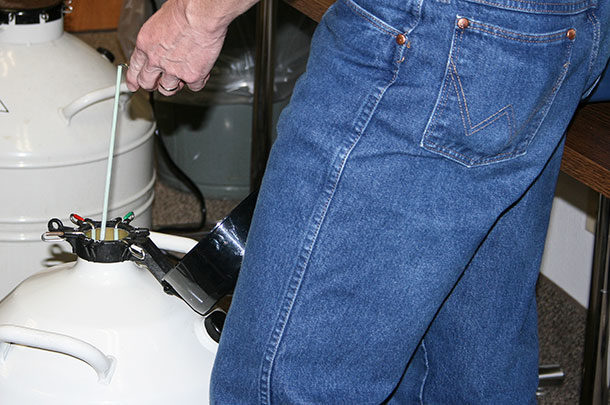Why use pooled semen? That was the question I asked myself a year ago when the National Association for Animal Breeders (NAAB) saw an uptake in the sales of this product. As a dairy geneticist, I am trained to preach precision breeding for high genetic gain. Therefore, mixing multiple bulls in one semen straw felt counterintuitive.
But the dairy industry is not what it was 50, 30 or even 15 years ago. Progressive producers continue to respond to market circumstances and diversify breeding strategies for higher herd profitability. The incredible speed with which producers change breeding strategies and the A.I. industry responds is remarkable. Heterospermic semen is simply the newest tool for higher herd profitability – although it is not exactly new. What has changed?
While we admire our industry's agility, we must remember that it is traditional and rigid at its core. The last 10 years of innovation were preceded by multiple decades of consistently doing things the same way. This means that while we try, as a collective system, we have a hard time keeping up with the pace that is ever-accelerating. In the aggressive hunt for herd profitability, there lies a risk of overlooking important details. This is the case for both beef-on-dairy and pooled semen.
Why now?
The first research paper on mixed semen stems from the 1960s. The author concluded that fertility benefits were significant when mixing ejaculates of multiple Holstein bulls for use in A.I.
While it has been around and sporadically used since then, the recent increase in popularity is unprecedented. Why? Beef-on-dairy.
NAAB statistics show that sales of beef semen took off in 2017. Until then, beef semen sales had stayed constant and low given the relatively low use of A.I. in beef herds. However, a reduction in the pure beef population in 2013 created a demand for more beef animals. This came right after the dairy industry adopted two large innovations, namely genomic selection (2010) and sexed semen (2012-13, Figure 1). Dairy producers thereby had the means to strategically breed their replacement heifers, which left space for using beef semen on the bottom of the herd and answer the call for more beef animals.

Six years later, beef-on-dairy has firmly established itself in the genetic toolkit of dairy producers. Experts agree that it is here to stay for the foreseeable future or at least while the native beef numbers are low. Meanwhile, geneticists are working hard to create a crossbred product that is as good as purebred beef, so that the current need turns into an eventual want.
Since there hasn’t been intense genetic selection in beef relative to dairy, there is much progress to make. Bull studs have created specific genetic lines of beef bulls for dairy herds and increased the selection intensity for carcass and maternal traits. With that said, a survey conducted by the University of Wisconsin – Madison in 2019 showed that dairy producers do not have the finished product in sight when choosing beef bulls. The top three criteria for beef bull selection were reported as semen cost, conception rate and calving ease. Pooled semen fits this bill perfectly: It is generally more affordable, marketed on higher conception rate and can accommodate teams of bulls that excel in ease of calving.
Does it work?
The added value of heterospermic semen lies in better conception rates compared to homospermic semen. This is explained by the increased semen variability that is created when mixing semen of various bulls. The sperm in ejaculates are diverse and carry different ability to fertilize. There is variation among sperm within an ejaculate and among ejaculates of the same bull, but even more among ejaculates of different bulls. The heterogeneity or variability of the sperm in a straw can therefore be increased by mixing the ejaculates of multiple bulls. The idea is that the likelihood of conception is enhanced by a wider ovulation window due to an extended "life span" of the various sperm within the oviduct.
However, there is a great lack of published scientific research on the effect of heterospermic semen on conception rate. Therefore, we must conclude that marketing does play a role in its current success. That said, studies have been done by both commercial companies as well as universities, and two clear patterns are visible.
The first is that older research concludes a significant positive effect on fertility. All these studies were conducted using mixtures of Holstein and Guernsey semen. The second pattern emerges in the largely unpublished recent research done by commercial bull studs. No significant effect on fertility was concluded in heterospermic dairy semen (stud 1 – Holstein, 3 bulls, 3,384 breedings), but higher conception rates were observed in use of heterospermic beef semen (stud 2 – Belgian Blue, 3 bulls, 1,988 breedings).
This makes sense. The heavy use of A.I. in dairy herds meant intensive selection for fertility in dairy bulls. Bad breeders were instantly culled. Genetic selection has thereby reduced the variability in dairy male fertility, which should result in a reduced added benefit of a mixed straw. This explains why older studies see increased fertility from mixed dairy straws while recent studies do not. This strong selection for male fertility has not taken place in beef. On average, semen quality of beef bulls is lower than that of dairy bulls. Mixing beef bulls therefore shows to still have added value as the heterogeneity of the sperm does increase due to the larger variability (confidence interval) still found in beef semen. More published studies on this topic would be welcome to confirm this hypothesis.
What we don't know
The beef-on-dairy "revolution" can be observed through NAAB statistics that show increased beef semen sales. NAAB statistics from 2022 presented an increase of 6% for beef-on-dairy unit sales in 2022 over 2021, closing the year at almost 7 million total units sold. NAAB statistics also show that 61% of total beef semen sales is currently going into dairy herds. However, we know that this is an underestimate. NAAB only collects data from NAAB regular members and/or Certified Semen Services (CSS) participating facilities. While this covers approximately 95% of the dairy industry, it does not have near such a wide coverage in the beef world.
It is therefore known that much more beef semen is sold to dairy producers. These units are not traced, and the semen is not CSS-approved. This doesn’t need to be a problem, but it can be. The dairy industry is used to the bulk of the semen being safe through audits of collection centers for bull health and semen quality. CSS was not widely adopted in the beef industry partly because its required testing scheme adds money and time to the seasonal breeding window of the beef industry. However, beyond CSS there are no mandatory regulatory programs for collection centers that guarantee semen safety.
Disease
Dairy producers must therefore be on increased alert when using beef semen (both normal and pooled) in the dairy herd. It is of even more importance to know when the semen was produced and what their health testing program includes. The gain in profitability from using beef-on-dairy can be lost fast by introducing trichomoniasis, campy, BVD or leptospirosis via use of semen from an infected sire.
Data
While we believe pooled semen is increasing in popularity, we don’t know how much pooled semen is used. We don’t have the data.
Normally, the NAAB (or cane) code of the bull links a breeding event to a service sire. This data is used for statistics by herd management software packages as well as by genetic evaluation centers for calculation of breeding values. The industry is used to bulls having their own unique identifying NAAB code. Much of our data flow for the national evaluation of A.I. sires is built on this assumption. Heterospermic semen, however, forces us to change that now, as one NAAB code links to multiple donor bulls.
A recent policy by CSS requires CSS participants to label heterospermic semen with "pooled semen." Teams of bulls (with a maximum of 6) may be used to create the mixture. If a new bull gets introduced to the team, a new NAAB code must be allocated. Collection centers are also obliged to record the NAAB code of the heterospermic unit, alongside the information of the donor bulls that can be in the semen straw for data traceability.
Although working hard to keep up, NAAB and other allied industry have not yet changed their systems to store and process the pooled semen NAAB codes. Any current breedings by this semen product are therefore not traced and do not flow through to any genetic evaluation or statistics on the donor bulls. Genomic testing can eventually identify the sire of the resulting progeny, but that is all after the fact. This creates another limitation to tracking the added fertility benefits of pooled semen on a national level and means we cannot trace the statistics on how much of this semen is currently used in U.S. dairy herds.
What's next?
More semen product diversity
We now also see sexed-sorted heterospermic packs of varying purity levels and thus volumes (Super Conventional, ST Genetics) and heterospermic packs with composite terminal genetic lines (NuEra, ABS Global). We believe that this diversification will continue. This will put pressure on semen traceability and will challenge the boundaries of semen labeling. Transparency will therefore become even more important, and producers should continue to question their semen suppliers on the origin of the product.
Do we need to know who sired which calf?
Of course, the answer to that question is "yes." We need to know what bull sired which calf for accurate genetic evaluation and genetic progress, herd book registration, for farm-to-table traceability and for trade regulations. These are all processes that are done by allied industry, away from a farm.
Does a producer need to know the bull that sired a calf? Do we need to know everything about that bull – multiple long names, multiple registration IDs, birthdate, six-generation-deep pedigrees, pictures of female family members? Or could we simply state: Bull A – good in X,Y and Z. It is a philosophical question and not a very popular one. Many of us are passionate about cow families and knowing the ins and outs of every popular bull. A world without it feels so much less romantic. And yet, the anonymity of pooled semen seems to be accepted – and therefore, it tastes like a baby step into a world where precision breeding may not be about matching bull and cow identities, but more about matching their unnamed genetic profiles.
The future
It is exciting to follow the rapid developments in reproductive advances of our industry. Trends are producer-driven, with price, demand and product all playing a role. It doesn’t stop here; we can expect a larger variety of semen products. However, when trends grow this quickly, important details may get missed and those "off the farm" processes may not keep up. Be aware that this is reality and avoid taking risk that could offset your gain. Make sure you know where and how your semen is produced. Ask questions to your semen supplier on bull health testing to limit risk of disease via semen use and record your breedings accurately via the pooled NAAB code on the straw. This will keep your herd healthy and genetic evaluations accurate once data flows are adjusted.
References omitted but are available upon request by sending an email to the editor.










